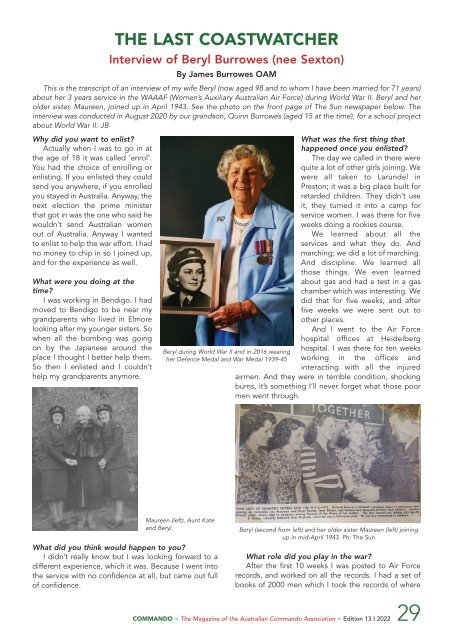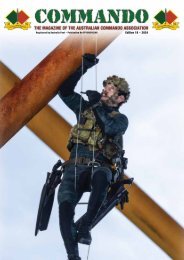Commando News Edition 13, 2022
Create successful ePaper yourself
Turn your PDF publications into a flip-book with our unique Google optimized e-Paper software.
THE LAST COASTWATCHER<br />
Interview of Beryl Burrowes (nee Sexton)<br />
By James Burrowes OAM<br />
This is the transcript of an interview of my wife Beryl (now aged 98 and to whom I have been married for 71 years)<br />
about her 3 years service in the WAAAF (Women’s Auxiliary Australian Air Force) during World War II. Beryl and her<br />
older sister, Maureen, joined up in April 1943. See the photo on the front page of The Sun newspaper below. The<br />
interview was conducted in August 2020 by our grandson, Quinn Burrowes (aged 15 at the time), for a school project<br />
about World War II. JB<br />
Why did you want to enlist?<br />
Actually when I was to go in at<br />
the age of 18 it was called ‘enrol’.<br />
You had the choice of enrolling or<br />
enlisting. If you enlisted they could<br />
send you anywhere, if you enrolled<br />
you stayed in Australia. Anyway, the<br />
next election the prime minister<br />
that got in was the one who said he<br />
wouldn’t send Australian women<br />
out of Australia. Anyway I wanted<br />
to enlist to help the war effort. I had<br />
no money to chip in so I joined up,<br />
and for the experience as well.<br />
What were you doing at the<br />
time?<br />
I was working in Bendigo. I had<br />
moved to Bendigo to be near my<br />
grandparents who lived in Elmore<br />
looking after my younger sisters. So<br />
when all the bombing was going<br />
on by the Japanese around the<br />
place I thought I better help them.<br />
So then I enlisted and I couldn’t<br />
help my grandparents anymore.<br />
What was the first thing that<br />
happened once you enlisted?<br />
The day we called in there were<br />
quite a lot of other girls joining. We<br />
were all taken to Larundel in<br />
Preston; it was a big place built for<br />
retarded children. They didn’t use<br />
it, they turned it into a camp for<br />
service women. I was there for five<br />
weeks doing a rookies course.<br />
We learned about all the<br />
services and what they do. And<br />
marching; we did a lot of marching.<br />
And discipline. We learned all<br />
those things. We even learned<br />
about gas and had a test in a gas<br />
chamber which was interesting. We<br />
did that for five weeks, and after<br />
five weeks we were sent out to<br />
other places.<br />
And I went to the Air Force<br />
hospital offices at Heidelberg<br />
hospital. I was there for ten weeks<br />
Beryl during World War II and in 2016 wearing<br />
her Defence Medal and War Medal 1939-45 working in the offices and<br />
interacting with all the injured<br />
airmen. And they were in terrible condition, shocking<br />
burns, it’s something I’ll never forget what those poor<br />
men went through.<br />
Maureen (left), Aunt Kate<br />
and Beryl.<br />
What did you think would happen to you?<br />
I didn’t really know but I was looking forward to a<br />
different experience, which it was. Because I went into<br />
the service with no confidence at all, but came out full<br />
of confidence.<br />
Beryl (second from left) and her older sister Maureen (left) joining<br />
up in mid-April 1943. Ph: The Sun<br />
What role did you play in the war?<br />
After the first 10 weeks I was posted to Air Force<br />
records, and worked on all the records. I had a set of<br />
books of 2000 men which I took the records of where<br />
COMMANDO ~ The Magazine of the Australian <strong>Commando</strong> Association ~ <strong>Edition</strong> <strong>13</strong> I <strong>2022</strong> 29
















